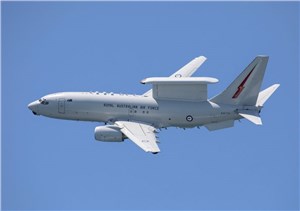MESA is Evolving Combat Identification in the Battlespace
March 20, 2025
-For over 75 years, Airborne Early Warning & Control platforms have been indispensable assets to military forces around the globe. From early detection and surveillance to air defense and strategic deterrence, they are crucial to ensuring air superiority.
One such platform plays a pivotal role in airborne command and control and battle management: the E-7. Working as part of a larger network of platforms and systems, the E-7 serves as the airborne mission conductor, allowing operators to assess the landscape and direct fleet operations accordingly. This is made possible by having a comprehensive picture of the operational environment.
Northrop Grumman’s Multi-Role Electronically Scanned Array (MESA) — the multifunction surveillance sensor for the E-7 — provides operators 360-degree coverage of the battlespace and the ability to detect, track and classify a wide array of airborne, maritime and ground threats from long ranges. This real-time data is used to orchestrate the fleet in dynamic situations for effective mission execution.
Battle-Tested and Continuously Modernized
MESA’s combat identification (ID) technology — a key differentiator on the sensor — determines and discriminates friendly assets from potential threats and allows operators to manage operations dynamically at mission speed. In rapidly changing environments, the flexibility and agility of this technology maximizes the effectiveness of allied forces and strengthens engagement decisions.
In collaboration with Boeing and the Royal Australian Air Force (RAAF), Northrop Grumman recently developed enhanced combat ID capabilities for MESA, and integrated and tested the updates using an operational E-7 aircraft. Rather than simulating performance via a testbed aircraft, an in-service E-7 was utilized to perform these flight tests, reflecting the technical maturity and mission readiness of these capabilities.
The mission system integration and subsequent flight tests were conducted from RAAF Base Williamtown, home to Australia’s E-7 aircraft. Flying in a true mission environment with these advanced capabilities for the first time, MESA identified air threats and securely processed key intel faster than ever before.
“Military operators need instant, precise identification data to make real-time decisions, especially as the battle landscape continues to advance at an exceedingly rapid pace,” said Ed Griebel, vice president of airborne surveillance programs, Northrop Grumman. “We’re modernizing our multifunction sensor technology – including MESA – to deliver resilient capabilities quickly and without disruption.”
One Team, One Global Fight
Northrop Grumman delivers critical capabilities and mature technologies to keep allied forces operating ahead of enemy threats. The use of digital transformation and advanced manufacturing, coupled with extensive testing practices, allow Northrop Grumman to scale production efforts and execute with speed and discipline.
“MESA’s performance is a testament to Northrop Grumman’s commitment to program execution and operating in a digital ecosystem,” said Griebel. “Working in a seamless environment with our customers and suppliers ensures our systems directly reflect customer needs and the current environment, and that they work the first time, every time.”
The collaboration and real-time feedback allow Northrop Grumman to make enhancements when needed, thanks to the open systems architecture of both the E-7 and MESA. The E-7 serves as a critical communications node for the joint force —a conductor, if you will — and relies on its advanced sensing and interoperability to make sure the fleet is in the right place at the right time.
The Northrop Grumman team, alongside customers and platform operators, will integrate these enhanced combat ID capabilities across current and future E-7 fleets. MESA is currently in production for the U.S. and Royal Air Forces and actively fielded on E-7s for the Royal Australian, Turkish and Republic of Korea Air Forces.
Source : Northrop Grumman Corporation

Related Studies


